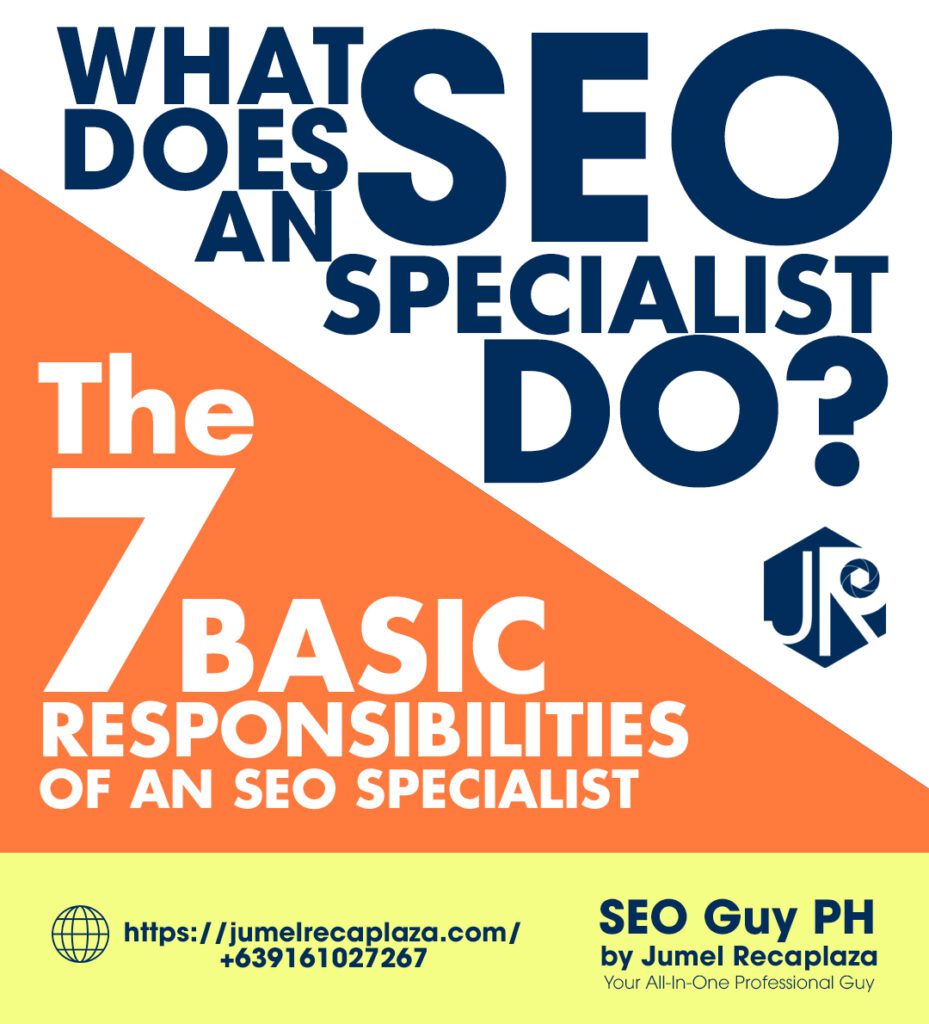What is an SEO Specialist: How to Become an Expert
What is SEO Specialist
It is also known as a Search Engine Optimization specialist, is a professional who specializes in improving the visibility and ranking of websites or web pages in search engine results. Their primary goal is to drive organic (non-paid) traffic to a website by optimizing its content, structure, and various elements to align with search engine algorithms.

In the contemporary era, having a strong online presence is crucial for businesses to achieve successful sales, as the internet has become a vital companion. Nowadays, most businesses heavily depend on the internet to establish their own websites, aiming to attract customers and provide detailed information about their products or services. As a primary means of finding what they need, consumers often resort to using search engines like Google, which holds the title of the most widely used search engine on the planet. To ensure their websites appear prominently in specific search queries, business owners often seek the expertise of SEO specialists, whose role is to optimize and elevate their website rankings in the Search Engine Results Pages (SERPs). In this article, we will talk about and learn what SEO Specialists DO and HOW to become one and good at it.
What does an SEO Specialist do


The 7 basic responsibilities of an SEO Specialist:
- Keyword Research
- On-page Optimization
- Off-page Optimization
- Technical SEO
- Content Development
- Performance Analysis
- Keeping up with Industry Trends
1. Keyword Research
Identifying relevant keywords and phrases that potential visitors might use to find the website’s content.
SEO keyword research is a crucial first step in any successful search engine optimization strategy. Here is a step-by-step manual for conducting keyword research:
Understand Your Target Audience: Begin by understanding your target audience, their needs, interests, and the language they use when searching for products or services related to your business.
Brainstorm Seed Keywords: Come up with a list of general, broad keywords related to your business. These are known as seed keywords and will serve as the starting point for your research.
Use Keyword Research Tools: Utilize keyword research tools to expand your list of potential keywords. Google Keyword Planner, SEMrush, Ahrefs, Moz Keyword Explorer, and Ubersuggest are a few of the often used programs. These tools offer perceptions into keyword difficulty, search volume, and related terms.


Analyze Competitor Keywords: Study your competitors’ websites to identify keywords they are targeting. This can give you valuable insights and help you discover relevant keywords you may have missed.
Focus on Long-Tail Keywords: Long-tail keywords are more specific and typically have lower search volume but higher conversion potential. They often reflect the intent of users closer to the purchasing phase. Incorporate relevant long-tail keywords into your list.
Consider Search Intent: Pay attention to the search intent behind keywords. Determine whether users are searching for information, products, services, or are looking to take a specific action (e.g., download, buy, sign up).
Group Keywords by Relevance: Group the keywords into themes or categories based on their relevance to your products or services. This will help in organizing your content and optimizing specific pages.
Evaluate Keyword Difficulty: Assess the keyword difficulty or competition level for each keyword. Focus on a mix of low, medium, and high difficulty keywords to balance your efforts.
Prioritize and Select Keywords: Prioritize the keywords based on their relevance, search volume, and competitiveness. Select terms that best support your company’s objectives.
Monitor and Update: Keep track of the performance of your chosen keywords and be ready to adapt and update your strategy based on changing trends and user behavior.
Remember that SEO is an ongoing process, and keyword research is not a one-time task. Regularly revisit and refine your keyword list to stay relevant and competitive in the ever-changing landscape of search engine optimization.
2. On-page optimization


Op-Page Optimization is the process of making individual web pages more search engine-friendly. This involves adjusting meta tags, headings, content, and internal linking to improve their relevance and readability.
On-page optimization is the practice of improving the visibility and relevance of individual web pages for particular target keywords. Here’s a step-by-step guide on how to do on-page optimization effectively:
Keyword Selection: Choose the target keyword or phrase for each web page based on keyword research. Select keywords that accurately represent the content of the page and have a reasonable search volume.
Title Tag: Create a compelling and descriptive title tag that includes the target keyword near the beginning. Keep it within 60 characters to ensure it displays correctly in search engine results.
Meta Description: Write a concise and engaging meta description that contains the target keyword. The meta description should summarize the page content and encourage users to click through from search results.
Heading Tags: Use heading tags (H1, H2, H3, etc.) to structure your content logically. Include the target keyword in the main heading (H1) and use subheadings (H2, H3) to organize the content.
URL Structure: Optimize the URL of the page to include the target keyword and make it user-friendly. Use hyphens to separate words and avoid using long strings of numbers or irrelevant characters.
Content Optimization: Create high-quality, valuable content that revolves around the target keyword. Use variations of the keyword and related terms naturally throughout the content. Aim for a comprehensive, well-structured, and easy-to-read format.
Image Optimization: Optimize images by using descriptive alt tags that include the target keyword. Compress the images to reduce page load time without compromising quality.
Internal Linking: Link to other relevant pages within your website using anchor text that includes keywords related to the linked page’s content. Internal linking helps establish website hierarchy and improves user navigation.
External Linking: Include outbound links to reputable and relevant external sources. Linking to authoritative websites adds credibility to your content.
Mobile-Friendliness: Ensure your web page is mobile-friendly and responsive to different screen sizes. Mobile optimization is essential for user experience and search engine rankings.
Page Loading Speed: Optimize page loading speed by compressing images, leveraging browser caching, and using a content delivery network (CDN) if necessary. Pages that load more quickly typically appear higher in search results.
Schema Markup: Consider adding relevant schema markup to your content. Schema markup helps search engines better understand the context of your content and may lead to rich snippets in search results. Visit this link to create specific schema markup – https://technicalseo.com/tools/schema-markup-generator/
User Experience: Prioritize user experience by organizing content logically, using easy-to-read fonts, and ensuring a clean and clutter-free design.
Regular Review: Periodically review and update your on-page optimization to stay relevant and maintain search engine rankings.
Remember that on-page optimization is not just about search engines; it’s also about providing valuable content and a positive user experience. Strive to create content that satisfies the user’s search intent and addresses their needs effectively.
3. Off-Page Optimization
Building high-quality backlinks from other websites to improve the website’s authority and credibility in the eyes of search engines.
Off-page optimization, also known as off-site SEO, involves optimizing factors outside of your website to improve its authority, credibility, and reputation in the eyes of search engines. The primary focus of off-page optimization is to build high-quality backlinks from reputable sources and engage with your target audience across various online platforms. Here’s a step-by-step guide on how to do off-page optimization effectively:
Link Building: Earn high-quality backlinks from relevant and authoritative websites. Seek out opportunities for guest posting, outreach to industry influencers, and get mentioned or linked by reputable websites. Avoid spammy and low-quality link-building practices, as they can harm your website’s rankings.
Content Marketing: Create material that is worthwhile and shareable and will inevitably draw links from other websites. The creation of inbound links can benefit greatly from the use of educational blog posts, infographics, videos, and tutorials.
Social Media Engagement: Engage your audience directly on social media sites. Share your content, reply to messages and comments, and take part in topics that are pertinent. Social signals can indirectly influence search engine rankings.
Influencer Outreach: Collaborate with influencers and industry leaders who have a substantial following. Their endorsements and mentions can lead to increased exposure and credibility for your brand.
Online Reviews and Citations: Encourage satisfied customers to leave positive reviews on review platforms relevant to your industry. Also, ensure your business information (Name, Address, Phone number) is consistent across various online directories and citation sites.
Social Bookmarking: Submit your content to reputable social bookmarking websites like Reddit, Digg, and StumbleUpon. This can help drive traffic and gain exposure for your content.
Forum Participation: Take part in appropriate online forums and communities. Offer valuable insights and solutions to users’ questions while including a link to your website only when relevant and allowed by the forum’s guidelines.
Broken Link Building: Identify broken links on other websites related to your content. Reach out to the website owners and offer your content as a replacement, providing value to their audience.
Local SEO: If your business has a physical location, optimize your website for local search by claiming and optimizing your Google My Business listing and ensuring consistent NAP information (Name, Address, Phone number) across local directories.
Monitor Brand Mentions: Use tools to monitor brand mentions and unlinked mentions of your website or content. Reach out to the source and politely request a link back to your site if appropriate.
Build Relationships: Build relationships with other website owners, bloggers, and influencers in your niche. Networking can lead to valuable link-building opportunities and collaboration.
Monitor Backlink Profile: Regularly analyze your website’s backlink profile using tools like Ahrefs or Moz to identify and disavow any harmful or spammy links that may negatively impact your rankings.
Remember that off-page optimization requires a consistent and ethical approach. Focus on providing value to your audience and building genuine relationships with other website owners and influencers in your industry. Quality backlinks from reputable sources can significantly boost your website’s authority and improve search engine rankings over time.
4. Technical SEO
Addressing technical aspects of the website, such as site speed, mobile-friendliness, and indexing issues, to ensure it is easily crawlable and indexed by search engines.
Technical SEO include improving your website’s technical characteristics to increase its crawlability, indexability, and overall performance in search engines. Here’s a step-by-step guide on how to do technical SEO effectively:
Website Speed Optimization:
Compress images: Reduce image file sizes without compromising quality to improve page loading speed.
Enable browser caching: Set cache-control headers to allow browsers to store cached versions of your pages, reducing load times for returning visitors.
Minimize HTTP requests: Combine CSS and JavaScript files, and reduce the number of external scripts to decrease the number of server requests.
Use a Content Delivery Network (CDN): Distribute website files across multiple servers worldwide to serve content from the closest server to the user, reducing latency.
Web Speed Checker Tool: https://pagespeed.web.dev/
Mobile-Friendly Optimization:
Implement responsive design: Make sure your website adapts to various screen sizes and devices without a hitch.
Test for mobile usability: Use Google’s Mobile-Friendly Test to check if your site meets mobile usability standards.
Website Structure and Navigation:
Create a logical and organized website structure: Make sure your site is easy to navigate, with clear categories and hierarchical menus.
Use breadcrumbs: Implement breadcrumb navigation to help users and search engines understand the page’s position within the site’s hierarchy.
XML Sitemap: Create an XML sitemap and submit it to search engines to help them discover and index your pages more efficiently. Install a plug-in called Yoast SEO or similar like Rank Math.
URL Structure:
Use descriptive and user-friendly URLs: Optimize URLs to include relevant keywords and avoid unnecessary parameters or dynamic URLs.
Canonicalization:
Set canonical tags: Use canonical tags to indicate the preferred version of a URL when there are multiple versions of the same content.
Robots.txt File:
Create and maintain a robots.txt file: Use it to control search engine crawlers’ access to specific pages and directories on your site.
HTTPS and SSL:
Secure your website with HTTPS: Install an SSL certificate to encrypt data transmission and ensure a secure browsing experience for users.
Schema Markup:
Implement schema markup: Use structured data to provide additional context to search engines about your content, leading to rich snippets in search results.
Check for Duplicate Content:
Identify and resolve duplicate content issues: Use tools like Screaming Frog, Copyscape or Siteliner to find duplicate content and take corrective actions.
404 Error Pages:
Customize your 404 error pages: Create user-friendly 404 pages with relevant links and information to help users find what they’re looking for.
Monitor and Maintain:
Regularly monitor your site’s performance using tools like Google Search Console and fix any crawl errors or issues promptly.
Technical SEO is essential to ensure that search engines can efficiently crawl, index, and understand your website’s content. You can establish a strong foundation for better user experience and search engine exposure by taking care of these technological issues.
5. Content Development:
Creating valuable and engaging content that not only attracts visitors but also aligns with the website’s targeted keywords.
6. Performance Analysis:
Monitoring and analyzing website performance using tools like Google Analytics to assess the effectiveness of the SEO strategies and make data-driven improvements.
7. Keeping Up with Industry Trends:
Staying updated with the latest search engine algorithm changes and SEO best practices to adjust the optimization strategies accordingly.
SEO specialists play a crucial role in helping websites achieve higher rankings in search engine results, which ultimately leads to increased organic traffic and potential conversions for businesses or organizations. It’s essential for an SEO specialist to have a good understanding of how search engines work and continuously adapt their strategies to maintain or improve a website’s position in search results.
How to be a GOOD SEO Specialist, here are some essential steps:
Learn SEO Fundamentals: Understand the basic concepts of search engine optimization, including keyword research, on-page optimization, and link building.
Tips: There are several online SEO courses available on the internet, such as SEMrush Academy, MOZ, and Ahrefs. If you’re from the Philippines, I recommend checking out PinoySEO, a tutorial website that offers SEO training in Filipino, making it easy to understand. They provide both FREE and Paid training options. One of their notable offerings is the ongoing SEO Online Bootcamp, a 4-week intensive learning program that covers the entire SEO cycle, starting from Keyword Research and ending with Data Analysis. Click here to have your 5% discount.
Study Search Engine Algorithms: Familiarize yourself with how search engines like Google rank websites and the factors that influence search results.
Stay Updated: The field of SEO constantly evolves, so it’s essential to stay current with industry news, updates, and changes in search engine algorithms.
Practice Technical Skills: Develop your technical skills related to website structure, HTML, and CSS, as technical SEO is a crucial aspect of optimization. You can use W3Schools tools to practice.
Use SEO Tools: Familiarize yourself with popular SEO tools like Google Analytics, Google Search Console, Ahrefs, Moz, SEMrush, etc., to gather data and insights.
Analyze Competitors: Study the strategies of successful competitors to understand what works well in your industry.
Create Quality Content: Learn to create valuable and engaging content that satisfies user intent and aligns with targeted keywords.
Network and Learn from Others: Engage with the SEO community, Join a Facebook Group, attend conferences, webinars, and join online forums to learn from experienced professionals.
Practice Patience: SEO results take time, so be patient and persistent in your efforts.
Measure Results: Continuously monitor and analyze the impact of your SEO strategies and make data-driven adjustments accordingly.
By combining theoretical knowledge with practical experience and keeping abreast of industry trends, you can become a skilled SEO Specialist in the Philippines and deliver effective results for websites striving to improve their search engine rankings and online visibility.

